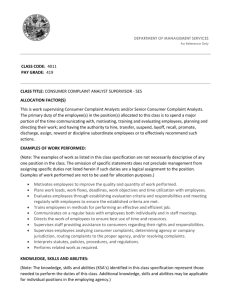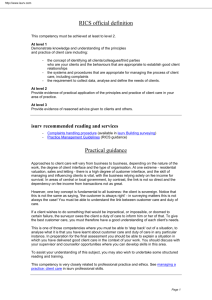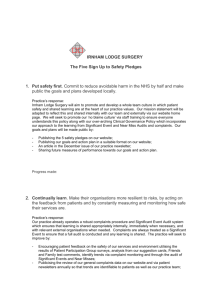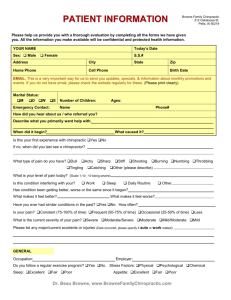Health complaints associated with prolonged computer use as
advertisement
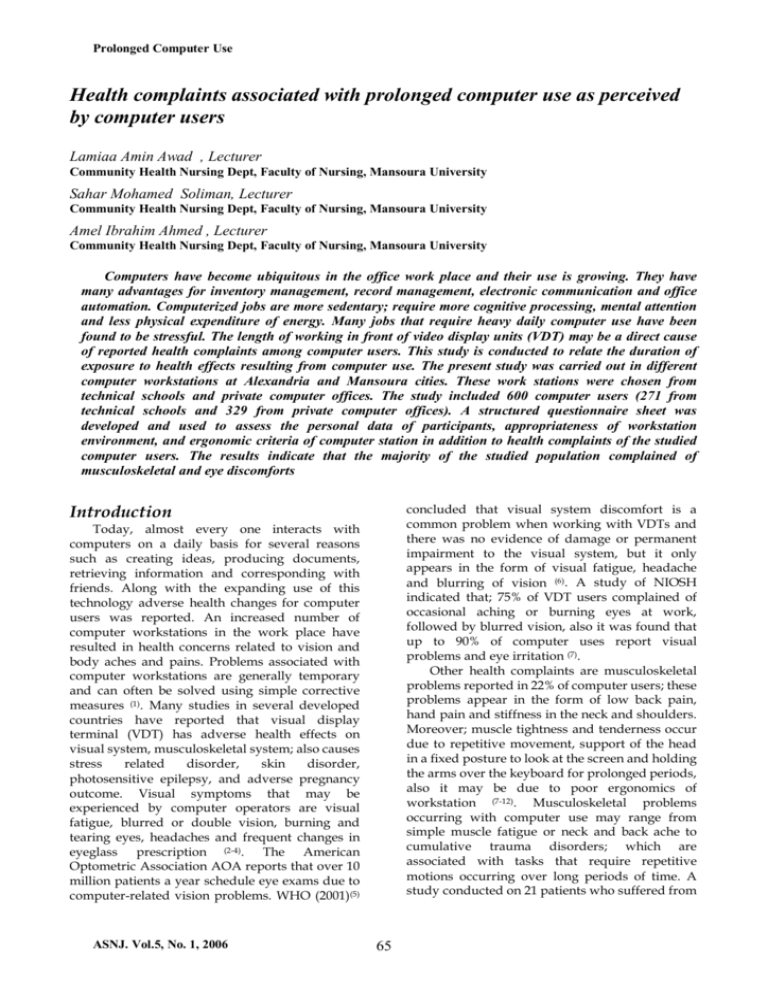
Prolonged Computer Use Health complaints associated with prolonged computer use as perceived by computer users Lamiaa Amin Awad , Lecturer Community Health Nursing Dept, Faculty of Nursing, Mansoura University Sahar Mohamed Soliman, Lecturer Community Health Nursing Dept, Faculty of Nursing, Mansoura University Amel Ibrahim Ahmed , Lecturer Community Health Nursing Dept, Faculty of Nursing, Mansoura University Computers have become ubiquitous in the office work place and their use is growing. They have many advantages for inventory management, record management, electronic communication and office automation. Computerized jobs are more sedentary; require more cognitive processing, mental attention and less physical expenditure of energy. Many jobs that require heavy daily computer use have been found to be stressful. The length of working in front of video display units (VDT) may be a direct cause of reported health complaints among computer users. This study is conducted to relate the duration of exposure to health effects resulting from computer use. The present study was carried out in different computer workstations at Alexandria and Mansoura cities. These work stations were chosen from technical schools and private computer offices. The study included 600 computer users (271 from technical schools and 329 from private computer offices). A structured questionnaire sheet was developed and used to assess the personal data of participants, appropriateness of workstation environment, and ergonomic criteria of computer station in addition to health complaints of the studied computer users. The results indicate that the majority of the studied population complained of musculoskeletal and eye discomforts Introduction concluded that visual system discomfort is a common problem when working with VDTs and there was no evidence of damage or permanent impairment to the visual system, but it only appears in the form of visual fatigue, headache and blurring of vision (6). A study of NIOSH indicated that; 75% of VDT users complained of occasional aching or burning eyes at work, followed by blurred vision, also it was found that up to 90% of computer uses report visual problems and eye irritation (7). Other health complaints are musculoskeletal problems reported in 22% of computer users; these problems appear in the form of low back pain, hand pain and stiffness in the neck and shoulders. Moreover; muscle tightness and tenderness occur due to repetitive movement, support of the head in a fixed posture to look at the screen and holding the arms over the keyboard for prolonged periods, also it may be due to poor ergonomics of workstation (7-12). Musculoskeletal problems occurring with computer use may range from simple muscle fatigue or neck and back ache to cumulative trauma disorders; which are associated with tasks that require repetitive motions occurring over long periods of time. A study conducted on 21 patients who suffered from Today, almost every one interacts with computers on a daily basis for several reasons such as creating ideas, producing documents, retrieving information and corresponding with friends. Along with the expanding use of this technology adverse health changes for computer users was reported. An increased number of computer workstations in the work place have resulted in health concerns related to vision and body aches and pains. Problems associated with computer workstations are generally temporary and can often be solved using simple corrective measures (1). Many studies in several developed countries have reported that visual display terminal (VDT) has adverse health effects on visual system, musculoskeletal system; also causes stress related disorder, skin disorder, photosensitive epilepsy, and adverse pregnancy outcome. Visual symptoms that may be experienced by computer operators are visual fatigue, blurred or double vision, burning and tearing eyes, headaches and frequent changes in eyeglass prescription (2-4). The American Optometric Association AOA reports that over 10 million patients a year schedule eye exams due to computer-related vision problems. WHO (2001)(5) ASNJ. Vol.5, No. 1, 2006 65 Prolonged Computer Use neuropathy revealed that 86% of them reported aggravating factors of computer use during the months prior to the onset of symptoms, these factors are high work intensity, overwork and exceeding work duration causing an unusual strain (13). Also, one study conducted in 1998 on 382 high school students indicated that 4% had been diagnosed with carpal tunnel syndrome as a result of computer use (14). Regular computer use is associated with an increase in skin irritation most probably due to high level of dust particles that are attracted to the skin by a build-up of static electricity caused by the screen (15). Moreover, job stress manifested in VDT operators in the form of irritability and depression (16). not complete the questionnaire form, while 65 students complained from computer related symptoms before using computer, these were excluded from the study. The total number of students enrolled in the study was 271 students. 2- A number of 400 questionnaire sheet was distributed throughout the randomly selected eight private computer offices, out of them 329 computer users were included in the study. The rest were excluded from the study: 118 did not complete the questionnaire and 51 not conforming the study criteria. The total number of the study participants was 600 computer users. Criteria of the target population 1- Age up to ≤ 45 years 2- Computer work duration ≥ one year 3- Free from computer related symptoms before working in computer field; these symptoms are musculoskeletal complaints (backache, hand pain hand numbness, neck pain, and leg pain), visual complain and eye irritation symptoms, headache or irritability. Tool: A structured questionnaire form was developed by the researchers. It consisted of 31 closed ended questions and 5 open ended questions. It was used to assess the following: 1- Personal characteristics of the participants such as age, gender and level of education 2- Data of using computer such as, reasons and duration of using computer 3Appropriateness of workstation environment such as room temperature, light, ventilation, presence of air draft and noise. 4- Ergonomic criteria of computer station such as, seat, key board, mouse and monitor criteria to be described as comfortable or not as perceived by participants. In addition to questions that describe the size and shape of mouse and distance of the monitor from user. 5- Health complaints of the studied computer users as perceived by them. A list of computer related symptoms namely; musculoskeletal complaints (backache, hand pain hand numbness, neck pain, and leg pain), visual complain and eye irritation symptoms, headache or irritability to be checked, according to its presence before or after using computer. Aim of the study: To identify health complaints associated with prolonged computer use as perceived by computer users. Materials and methods: Study design: The study was a cross- sectional survey to investigate the effect of prolonged computer using on human health. Settings: The present study was carried out in twelve computer workstations at Alexandria and Mansoura cities. These work stations were chosen from four technical schools and eight private computer offices. The technical schools were chosen by using multistage sampling technique as follows: Two districts were chosen randomly from each city (middle and eastern districts in Alexandria and western and eastern districts in Mansoura) A list of nine technical schools having computer branches in the four selected districts were obtained. Out of them technical schools that have computer branch were selected (five schools in Alexandria and four schools in Mansoura). From these technical schools two were selected randomly in each city (one school from each district). The eight private computer offices were chosen by simple random technique (five located in the middle and eastern districts of Alexandria and three from western and eastern districts of Mansoura). Subjects: 1- All students studying computer science enrolled in the second and third year in the selected four technical schools were included in the study (500 students). Of these 94 students refused to participate in the study, 70 students did ASNJ. Vol.5, No. 1, 2006 Method: 1-Administrative process: a- Informal visit to the schools and workstations was done by the researchers to introduce the study and obtain their cooperation. 66 Prolonged Computer Use b- Oral approval was obtained from schools managers and workstations directors. c- Oral approval was obtained from participants to be included in the study. 2-Development of the study tool: a- The researchers developed the questionnaire form after reviewing of recent literatures then the content validity was tested by experts in that field. b- A pilot study was carried out on 20 computer users. These were chosen randomly from other computer workstation to ensure the clarity of the questionnaire. 3-Data collection: a- Data collection was conducted during the period from October 2004 to March 2005 through the interview of participants during visits to work stations on two days per week to explain the aim of the work, the meaning of questions and the method of questionnaire filling. Each visit consumed approximately 1.30 to 3 hours. b- Data was scanned to exclude individuals who do not fulfill the stated criteria of the target population. Statistical analysis SPSS package (version 0.9) was used for the statistical analysis of the obtained data. Kendall'stau- b test was used to estimate the correlation between prolongation of computer usage and the occurrence of health complaints. Generally, the majority of computer workstations have a comfortable work environment as perceived by the studied population regarding temperature, ventilation, light and quietness. As regards to ergonomic features more than two thirds have a appropriate seat height and seat base while 51.5% have a suitable seat back. Almost one quadrant of them have arm and/ or foot rest in their workstations. Also nearly half of the studied computer users have appropriate angle of key board to elbow and key board fixers. Three quadrants use curvedsmall mouse and appropriate monitor distance (around 75cm) and monitor level in relation to vision span, also most of monitors are clear and have comfortable brightness table (3). Table (4) shows that the most prevailed health complaints among computer users are musculoskeletal complaints (neck pain in 48.5%, backache in 47.3%, hand pain in 43.7%, hand numbness in 27% and leg pain in 27%) and visual complaints (blurring of vision in 50.8%, eye fatigue in 46.7%, eye tearing 37.8%, eye redness 26.2% and eye itching 22.3%). Moreover; 24.7% and 11.5% of the studied population complain of headache and irritability respectively. All of these complaints started after at least one year of using computer. Table (5) describes the frequency of health complaints in relation to their onset. Eye complaints and musculoskeletal complaints have the highest frequency within the first and second years of using computer (3.2% and 14.5% of eye complaints, especially eye fatigue, blurring of vision and eye irritation in the form of tearing and itching.) and (2.8% and 12.5% of musculoskeletal complaints especially hand pain and neck pain) respectively. While Psycho- sensory complaints (headache and irritability) obviously appeared within the second and third year of using computer. Table (6) illustrates that duration of work and daily working hours have a positive significant correlation with the most of health complaints. All eye complaints are significantly correlated with duration of work except eye tearing which is insignificantly correlated with this factor. Also, eye complaints are significantly correlated with daily working hours except deterioration of vision is insignificantly correlated with this factor. While all musculoskeletal complaints which are significantly correlated with both duration of work and daily working hours except leg pain and hand numbness showed insignificant correlation. In addition irritability is significantly correlated with duration of work and daily working hours. Results It's apparent from demographic characteristics of computer users in table (1) that the ages of the computer users included in the study ranged from 13 up to 45 years and distributed in three age groups. The first group ≤18 constitute 48.3% of the studied population with a mean age of 16.8± 1.3 years, the second group aged from >18 to less than 30 years and they present 29.4% of the studied population with a mean age of 23.1± 3.3 years, and the third group aged >30 years to include 22.3% of studied population with mean age of 36.6± 1.3. The overall mean age is 23.1±8.1 years, more than half of them are males. Concerning computer using pattern; the mean duration of work is 4.9 ±3.6 years and the mean daily working hours is 3.7±2.8 hours. All of the participants reported that they don’t get a rest period during working hours. About 45% of the studied population is studying computer science followed by 35 % working in computer field as programmers or typist, and the rest of the studied population is using computer for retrieving information or entertainments table (2). ASNJ. Vol.5, No. 1, 2006 67 Prolonged Computer Use All of the studied population neither take break nor make physical exercise during work. Discussion: The computer's role as an essential office and home technological resource has developed faster than has general public understanding of potential health problems from poor body alignment and effects of long hours in front of a keyboard and screen. Moreover, since these conditions typically do not cause acute pain or other immediate warning signs, many people are slow to connect their initial discomfort to their computer use and associated poor ergonomics (17). This study revealed that 70% of the studied population suffered from musculoskeletal discomfort namely, neck pain, hand pain and backache. These results are in agreement with other studies that reported a high prevalence of musculoskeletal discomfort among computer users in the form of neck pain, backache and hand pain (18-21). This musculoskeletal complaints; may be due to poor ergonomic environment that may lead to cumulative trauma, unhealthy posture, fixed position for extended period of time and/ or lacking for performing simple physical exercise to improve blood circulation. Computer vision syndrome is the number one cause of eye strain in the computer work station. Working at the computer is visually demanding, it requires excessive ocular motility, continuous eye focusing and alignment demands (22- 23). Problems occur when these demands exceed the visual ability of an individual. Studies conducted in Egypt (2000) (3), Australia (2000) (24) and Italy (1999)(25) found that eye discomfort was associated with computer use, mainly eye strain, deterioration of vision, aching or burning eyes and blurred vision. All of mentioned results agreed with the present study that revealed several eye complaints that are eye fatigue, blurring of vision, redness of eye, itching eye and deterioration in vision that lead to changing eye glass. Also the revealed headache and irritability among the studied population were reported by other researchers as a result of using computer (1, 26). These complaints may be due to the emission of chemical vapors and hotness from computers that contain a lot of plastics, and/ or prolonged focusing on computer screen. Extensive and prolonged use of computers at the work place and at home today, has given rise to a range of computer related health complaints. There are three broad categories of health problems, visual, musculoskeletal, and mental stress. The reasons for these problems are repetitive activities such as data entry and using ASNJ. Vol.5, No. 1, 2006 the keyboard, prolonged periods looking at the monitor, working with intense mental concentration, or alternatively, long periods of monotonous tasks (27). The more the hours users spent in front of a computer screen the higher the incidence of computer syndrome. Gerr and Monteilh C 2004 (28) reported an association between health outcomes and daily hours of computer use. The present study indicated a significant effect of work duration on eye discomfort, musculoskeletal discomfort and irritability either with duration of working years or duration of working daily hours. This result was similar to Al-Wehedy et al. (1999) (21) and Jensen 2004 (29) who found that the duration of computer use predicate a high prevalence of musculoskeletal disorders and headache that increase significantly with increasing the working years and daily working hours. Jackson et al 1997 (30) revealed that prolonged exposure to computer screen may lead to visual and general work related symptoms twice as frequently as those who spent less time working computer screen. Shimai et al 1986 (31) and Nakazawa et al 2002 (32) reported a positive correlation between musculoskeletal, eye discomfort and length of computer service. The length of daily working hours is considered as a risk factor for the development of musculoskeletal complaints among computer users (33). In addition, Rechichi et al 1996 (34) found that the main factor determining visual fatigue in VDT operators is the amount of time spent. Also, Travers and Stanton 2002 (35) found that visual disturbance manifestation appeared to increase as duration of video display terminals (VDT) increased. Many studies recommended that individual should have recovery time ranged from 10 to 15 minutes each hour during computer work. Also regular stretch break ranged from 30 o 60 second every half hour is needed to improve blood circulation and decrease the level of discomfort that is associated with sitting in one position (29, 36). Conclusion The study indicated that the prevalence of general disorders among computer users increase significantly with the duration of computer use and the number of working hours, also complaints started after at least one year of using computer and increased by time. Recommendations So it is recommended to perform a periodical medical checkup for early detection of sign and symptoms related to computer use, take at least ten minutes break each work hour and perform simple exercise during working time. 68 Prolonged Computer Use Table I: Distribution of the studied population according to personal characteristics Item Number 600 Percentage% Mean of ages (X±S.D) Personal data Age in years <18- 290 48.3 16.8±1.3 18- 176 29.4 23.1± 3.3 30+ 134 22.3 36.6± 1.3 Overall mean of ages 23.1± 8.1 (X±S.D) Gender Male 328 54.7 Female 272 45.3 ASNJ. Vol.5, No. 1, 2006 69 Prolonged Computer Use Table II: Distribution of the studied population according to features of computer using Number Item 600 Percentage% Number of years in using computer >5- 371 61.8 5- 136 22.7 10+ 93 15.5 X±S.D 4.9±3.6 Number of daily working hours in using computer >5- 436 72.7 5- 124 20.7 10+ 40 6.7 X±S.D 3.7±2.8 Reasons of using computer Studying computer sciences 271 45.2 Working in computer field 210 35 Entertainment 67 11.1 Retrieving information 52 8.7 ASNJ. Vol.5, No. 1, 2006 70 Prolonged Computer Use Table III: Distribution of computer workstation according to physical environment criteria as described by the studied population Number Item 600 Percentage% Workstation environment Suitable temperature 480 80 Suitable ventilation 449 74.8 Suitable light 420 70 Quiet room 378 63 Appropriate seat height 417 69.5 Comfort seat base 402 67 Comfort seat back 309 51.5 Presence of foot rest 145 24.2 Presence of arm rest 133 22.2 Presence of key board fixer 299 49.8 Appropriate angle of key board to elbow 259 43.2 Curved 513 85.5 Straight 87 14.5 Small 431 71.8 Large 169 28.2 Appropriate distance from user 447 74.5 Appropriate to vision level 378 63 Comfort brightness 488 81.3 Comfort clearance 468 78 Ergonomic appropriateness Seat criteria Key board criteria Mouse criteria Shape Size Monitor criteria ASNJ. Vol.5, No. 1, 2006 71 Prolonged Computer Use Table IV: Distribution of health complaints among the studied population Number Item 600 Percentage% Musculoskeletal complaints Neck pain 291 48.5 Hand numbness 284 47.3 Hand pain 262 43.7 Legs pain 162 27 Backache 141 47.3 Blurring of vision 305 50.8 Eye fatigue 280 46.7 Eye tearing 227 37.8 Eye redness 157 26.2 Eye itching 134 22.3 Deterioration of vision 96 16 Headache 148 24.7 Irritability 69 11.5 Eye complaints Psycho- sensory complaints Person may be presented by more than complaints ASNJ. Vol.5, No. 1, 2006 72 Prolonged Computer Use Table V: Distribution of health complaints according to their onset of occurrence Occurrence Occurrence Complaints within the second within the first year year Occurrence within the third year Number Percentage% Number Percentage% Number Percentage% Number= 14 3.2 63 14.5 358 82.3 Eye tearing 11 2.5 27 6.2 189 43.4 Eye fatigue 10 2.3 43 9.8 227 52.2 Blurring of vision 7 1.6 43 9.8 255 58.6 Eye itching 7 1.6 17 3.9 110 25.3 Eye redness 6 1.4 24 5.5 127 29.2 Eye complaints 435 Deterioration 4 vision 0.91 22 5.1 70 16.1 Musculoskeletal complaints 12 2.8 52 12.5 356 84.7 Hand pain 10 2.3 34 8 218 51.9 Neck pain 6 1.3 37 8.5 248 59 Hand numbness 5 1.2 28 6.6 137 32.6 Backache 3 0.7 21 5 251 59.7 Leg pain 2 0.5 23 5.5 117 27.8 5 3.1 41 25.3 116 71.6 Headache 5 3.2 32 19.7 111 68.5 Irritability 0.0 0.0 9 5.5 60 38.3 Number= 420 Psychosensory complaints Number= 162 Person may be presented by more than complaints ASNJ. Vol.5, No. 1, 2006 73 Prolonged Computer Use Table VI: Correlation between computer work duration and occurrence of health complaints Duration of work Complaints Daily working hours r P r P 0.097 0.006 0.246 0.000 0.286 0.000 0.294 0.000 Eye redness 0.282 0.000 0.256 0.000 Eye tearing 0.056 0.114 0.205 0.000 Eye itching 0.068 0.056 0.157 0.000 0.085 0.017 0.019 0.593 Neck pain 0.208 0.000 0.172 0.000 Hand pain 0.138 0.000 0.246 0.000 0.014 0.694 0.062 0.086 Backache 0.228 0.000 0.220 0.000 Leg pain 0.023 0.517 0.007 0.847 Headache 0.069 0.051 0.040 0.268 Irritability 0.229 0.000 0.246 0.000 Eye fatigue Blurring of vision Deterioration vision Hand numbness P ≤ 0.05 r = correlation coefficient ASNJ. Vol.5, No. 1, 2006 74 Prolonged Computer Use international scientific conference: Work with Diplay units. Stokholm, 2003; 17-20. References 1Kaplan and Sadock's. Anxiety disorder. In: Synopsis of Psychiatry: Behavioural sciences and clinical psychiatry. 8th ed. Giza. Mass publishing co: 2001; 583584. 12Al-Wehedy A, Hammad S.M, AlGilany A. Some health hazards among computer users. Benha Medical Journal, 2000; 16 (3) :601–615. 13Jørgen Riis Jepsen, Upper limb neuropathy in computer operators? A clinical case study of 21 patients. BMC Musculoskelet Disord. 2004; 5: 26. 2World Health organization (WHO). Update on visual display terminals and workers' health. Geneva: World Health Organization, 1999. 14Jones, C.S. and B.Orr. ComputerRelated Musculoskeletal Pain and Discomfort Among High School Students. Am. J. Health Stud; 1998; 14: 26. 3Emara AM. Health Hazards associated with work on video display terminals A WHO consideration. Egyptian J Occup Med; 2001; 15 (1): 105 – 108. 15Asia Monitor Resource Center (AMRC). 1993; Handbook on computer and health. Quated from Al-Wehedy A, Hammad S.M, Al-Gilany A. Some hazards among computer users, Benha Medical Journal, 1999; 16 (3) :601–615. 4Lim, S.Y, Carayon, P. An integrated approach to cumulative trauma disorders in computerized offices: the role of psychosocial work factors, psychological stress, and ergonomic risk factors. In: smith MJ, Salvendy G, Advances in human factors/ergonomics, 2001; 19A. 16Smith M.J, Cohen B.GF, Stammerjohn L.W. An investigation of health complaints and job stress in video display operations. Hum Factors, 2001; 23: 387– 400. 5World Health Organization (WHO). Video Display Units (VDUs) and human health, Fact Sheet No. 201. 2001; http://www.who.int/inffs/en/fact201.html 17Guidelines for Office Ergonomics. Computer and Workstation Equipment, 2006; 6: 6105. 6Computer program (3M). Office ergonomics, 2000; www.3m.com/intl/kr/office/pdf/ecrgono mic_2.pdf 18Lai, K.W. Computer use and potential health risk. Computers in New Zealand Schools, 1995; 7 (2): 43-47. 7Sauter S. Predictors of strain in VDT users and traditional office workers. In: Grandjean E. Ergonomics and health in modern offices. London Taylor and Francis; 2001; 129 – 135. 19Frank AL. Effects on health following occupational exposure to video display terminals. Lexington: University of Kentucky. Department of Preventive Medicine and Environmental Health Report, 2000; 40536: 84. 8Pascarellis E.F, Kella J.J. Soft tissue injuries related to use of the computer keyboard: a clinical study of 53 severely injured persons. J Occup Med; 2001; 3: 522 – 532. 20Solana. Sweden. Work with video display units. National Board of Occupational Safety and Health (NBOSH), Quoted from WHO (World Health Organization) (1987): Visual Display Terminals and Worker's Health. WHO Offset Publication Geneva; 1985; 99. 9Rempel D.M, Harrison R.J, Barnhart S. Work related cumulative trauma disorders of the upper extremity. JAMA; 2001; 267: 838 – 842. 10Armstrong T.J, Foulke J.A, Bernard J, Gerson J, Remple D.M. 2002; Investigation of applied forces in alphanumeric work. Am Ind Hyg Assoc; 55:30-35. 21Waheed A, Fouad M, Bassiouni H, Abdel-Aziz M. Health hazards of visual display terminals among exposed workers in Suez Canal cities. Mansoura Med ; 2000; 30 (2): 15-40. 11Ong C.N, Phoon W,O. Influence of age on VDT work. In: Proceedings of an 22the ASNJ. Vol.5, No. 1, 2006 1 Croasmun J. Easy on eyes= better on job. Ergonomic today TM; 2002; Prolonged Computer Use 31Shimai S, Iwasaki S, Takahashi M, Narita S, Suzuki H. Survey on subjective symptoms in VDT workers: complaint rate and years of service. Sangyo Igaku; 1986; 28 (2): 86- 95. http://www.ergoweb.com. 23Guetschow J. New ergonomic lines. Ergonomic today TM; 2000; http://www.ergoweb.com. 24Turner P.J. Visual requirement for VDT operators. Australian Journal of Optometry, 2000;65: 58-64. 32Nakazawa T, Okubo Y, Suwazono Y, Kobayashi E, Komine S, Kato N, Nogawa K. Association between duration of daily VDT use and subjective symptoms. Am J Ind Med; 2002; 42 (5): 421- 6. 25Rubino FG, di Bari A and Turbati M. Epidemiological analysis of discomfort signs. Boll Oculist; 1999; 68: 113-123. 26Bongers PM, Winter CR, Kompier MAJ and Hildebrandt VH. Psychosocial factors at work and nusculoskeletal diseases: a review of the literature. Scand J Work Enrviron Health; 2001; (19) 5:297-312. 27MANOJ DASG, Movements International Yoga for computer related health problems, Manoj Dash; 2005; http://groups.yahoo.com/group/Yoga. 28Gerr F, Marcus M, Monteilh C. Epidemiology of musculoskeletal disorders among computer users: lesson learned from the role of posture and keyboard use. J Electromyogr Kinesiol; 2004;14(1):25-31. 33Waersted M, Wstgaard R.H. Working hours as a risk factor in the development of musculoskeletal complaints. Ergonomics, 1991; 34 (3): 265- 76. 34Rechichi C, De Moja C.A, Scullica L. Psychology of computer use XXXVI. Visual discomfort and different types of work at video display terminals. Percept Mot Skills, 1996; 82 (3 Pt 1): 935- 8. 35Travers P.H, Stanton B.A. Office workers and video display terminals: physical, psychological and ergonomic factors. AAOHN J; 2002; 50 (11): 489- 93. 29Jensen C. Development of neck and hand-wrist symptoms in relation to duration of computer use at work. Scand J Work Environ Health; 2003; 29(3):197-205. 36Sheedy J.E. The bottom line on fixing computer- related vision and eye problems. Journal of the American Optometric Association. 1996; 67 (9): 515. 30Jackson A.J, Barnett E.S, Stevens A.B, McClure M, Patterson C, MeRynolds M.J. Vision screening, eye examination and risk assessment of display screen users in a large regional teaching hospital. Ophthalmic Physiol Opt; 1997; 17 (3): 187- 95. ASNJ. Vol.5, No. 1, 2006 2


